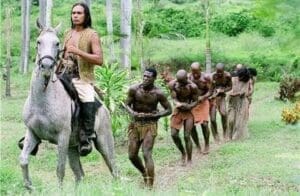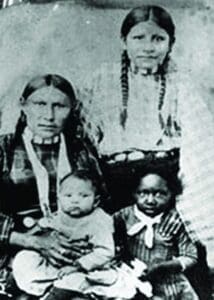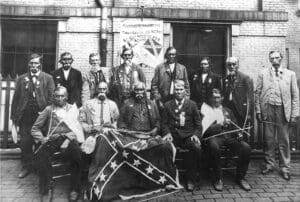The Untold Uprising: Cherokee Nation Slave Revolt of 1842
Table of Contents
- Introduction to the Cherokee Nation and Slavery
- Joseph Vann and His Plantation: A Stark Example of Slavery
- The Role of Black History Month in Unearthing Hidden Stories
- The 5 Civilized Tribes and Their Relationship with Slavery
- The Largest Slave Revolt in the Cherokee Nation
- Escape to Mexico: A Glimpse of Hope
- The Abolition of Slavery in the Cherokee Nation
- The Continuing Legacy of Slavery in the Cherokee Nation
- Conclusion
- Frequently Asked Questions
Introduction to the Cherokee Nation and Slavery
The Cherokee Nation, along with the other four tribes known as the Five Civilized Tribes (Chickasaw, Choctaw, Creek/Muscogee, and Seminole), played a significant role in Native American history in the southeastern United States. These tribes adopted certain aspects of European-American culture, such as written laws, centralized economies, and organized governments. However, their adoption of European practices also included the institution of slavery, which became prevalent among the tribes.
This article aims to shed light on the historical connection between the Cherokee Nation and Black Americans, particularly in the context of slavery. Understanding this relationship is crucial for a comprehensive understanding of Black American History, as it highlights the complex dynamics and intersections of culture, race, and oppression within the Native American context.
Joseph Vann and His Plantation: A Stark Example of Slavery

Joseph Vann, a prominent member of the Cherokee Nation, was a significant figure in the history of slavery within the tribe. Despite his mixed heritage, Vann became a brutal slave owner, perpetuating the dehumanizing institution among enslaved Black Americans. His plantation, situated in the Indian Territory, serves as a stark example of the prevalence of slavery among the Cherokee and the broader Five Civilized Tribes.
Vann’s plantation, characterized by its vast fields and opulent mansion, relied on the labor of enslaved Black Americans who were forcibly transported from their homelands. Their lives were marked by bondage, toil, and oppression. The existence of such plantations within the Cherokee Nation reveals the paradoxical nature of freedom and bondage that coexisted within these Native American communities.
The Role of Black History Month in Unearthing Hidden Stories
Black History Month serves as an important occasion not only to celebrate the achievements of Black Americans but also to uncover lesser-known narratives of Black history. Within the context of the Cherokee Nation and the Five Civilized Tribes, this month provides an opportunity to explore the often-overshadowed stories of Black Americans and their relationship with these Native American communities.
By delving deeper into the history of the Cherokee Nation, Creek/Muscogee, Choctaw, Seminole, and Chickasaw tribes, we gain insight into the experiences of enslaved individuals and their resilience in the face of adversity. These stories add nuance to our understanding of Black history, broadening the scope beyond the mainstream narrative of slavery among Black Americans in the United States.
The 5 Civilized Tribes and Their Relationship with Slavery
The involvement of the Five Civilized Tribes in the institution of slavery did indeed play a significant role in its perpetuation within the United States. These tribes, including the Cherokee Nation, aligned themselves with European-American practices, adopting aspects of agriculture and social structure that included slavery. While there were variations in their perspectives on slavery, it is crucial to recognize the substantial impact of these tribes in upholding the institution.

Slavery could not have existed and been maintained in the country without the full participation of the American tribes. This is why they were referred to as “civilized” because they actively engaged in slave hunting and trading. The Choctaw, Chickasaw, Cherokee, and Seminole tribes all fought alongside the South to preserve slavery, reaping benefits from it.
Between 1840 and 1860, which spanned over 20 years, the Indians from the Five Civilized Tribes were the primary perpetrators of violence against Black Americans. It is essential to acknowledge that they were slave traders and owners, with each tribe having its own level of involvement and acceptance of slavery.
The historical dynamics of the relationship between the Five Civilized Tribes and slavery are complex. It is crucial to understand these complexities to gain a comprehensive understanding of this period in history. However, it is important to approach this topic with nuance and avoid generalizations, as the actions and perspectives of individual tribes varied within the larger context of the institution of slavery.
The Largest Slave Revolt in the Cherokee Nation
On November 15, 1842, the Cherokee Nation experienced its largest slave revolt, which had significant implications for the nation’s history and the eventual abolition of slavery. The revolt, led by a group of enslaved individuals primarily from the Joseph Vann plantation, represented a courageous and determined resistance against the oppressive structures of bondage.
During the revolt, the enslaved individuals locked their masters and overseers in their homes and cabins while they slept. They seized weapons, horses, mules, ammunition, and supplies before embarking on a journey towards Mexico, where slavery was illegal. Along the way, they were joined by Creek slaves, amplifying the number of participants in their quest for freedom. The fugitives fought against and killed slave hunters in the Choctaw Nation, exemplifying their unwavering commitment to securing their human rights.
towards Mexico, where slavery was illegal. Along the way, they were joined by Creek slaves, amplifying the number of participants in their quest for freedom. The fugitives fought against and killed slave hunters in the Choctaw Nation, exemplifying their unwavering commitment to securing their human rights.
The Cherokee Nation responded by dispatching the Cherokee Militia, under the command of Capt. John Drew, to capture the runaways. The militia caught up with the slaves on November 28, 1842, seven miles north of the Red River. Exhausted and famished, the fugitives offered no resistance.
Escape to Mexico: A Glimpse of Hope
The oppressive conditions in the Cherokee Nation and the Indian Territory compelled many enslaved Black Americans to seek escape and find refuge in Mexico. Mexico, where slavery had been abolished by 1829, offered a glimpse of hope for those yearning for freedom. However, the journey to Mexico was perilous, with the constant threat of fugitive slave hunters lurking. The fact that individuals were willing to undertake such risks underscores the lengths they were prepared to go to attain their freedom.
Upon their return to Tahlequah on December 8, 1842, five Black American slaves were executed, and Joseph Vann forced the majority of his rebellious slaves to work on his steamboats, which operated on the Arkansas, Mississippi, and Ohio Rivers. The Cherokee Nation attributed the revolt to free, armed Black Seminoles who lived near the Cherokee slaves at Fort Gibson. As a result, on December 2, 1842, the Cherokee Nation enacted a law requiring all free Black Americans, except former Cherokee slaves, to leave the nation.
The Abolition of Slavery in the Cherokee Nation
The abolition of slavery within the Cherokee Nation occurred with the signing of the Treaty of 1866. The National Council of the Cherokees, confronted with the challenges of a post-Civil War era, eventually succumbed to the pressures of emancipation, putting an end to an oppressive chapter in the history of the Cherokee Nation.
It is worth noting that even after the Civil War ended, slavery persisted in certain areas, including Camp Smith in Texas, where the Choctaw and

Chickasaw tribes still held enslaved individuals. In response, the U.S. government offered $300,000 to these tribes as an incentive to release the enslaved individuals and provide them with land. Nevertheless, by 1869, freed individuals were reporting to Washington that they had not received the promised reparations. This situation underscores the disparities and complexities inherent in the relationship between the native tribes and the freed slaves.
The historical narrative of these interactions exposes systemic injustices faced by Black Americans, compounded by a lack of unity within the Black community. It also challenges the prevailing narrative of tribal solidarity, casting doubt on the assumed affinity between the enslaved individuals and their supposed native allies. This complexity enhances our understanding of the intricate socio-political dynamics of the time.
The Continuing Legacy of Slavery in the Cherokee Nation
While slavery was formally abolished in the Cherokee Nation, its legacy continues to influence the relationship between the Cherokee and Black Americans today. The ongoing discourse around race, identity, and tribal citizenship in the Cherokee Nation and the other 4 Civilized Tribes is a testament to the enduring influence of this dark chapter of history.
Conclusion
The perpetuation of slavery within the United States could not have occurred without the significant involvement of American tribal communities. This is evidenced by the transition of these groups from their

traditional hunting lifestyles to settled agricultural practices, which led to them being labeled as “civilized.” This transformation resulted in the native populations becoming slave captors, traders, and owners.
Among these communities were the Choctaw, Chickasaw, Cherokee, and Seminole tribes, collectively referred to as the “Five Civilized Tribes.” These tribes allied with the Confederacy during the American Civil War in an effort to preserve the institution of slavery, a system from which they garnered substantial benefits.
The issue of reparations emerges from these historical facts. Despite the cessation of the Civil War, the Choctaw and Chickasaw tribes continued to hold an estimated 12,000 to 15,000 enslaved individuals. In response to this, the U.S. government dispatched troops to dismantle the vestiges of slavery among these tribes, leading to the liberation of the enslaved individuals.
This act culminated in the establishment of the 1866 Indian treaties with the Five Civilized Tribes. These treaties decreed not only the release of enslaved black individuals but also the provision of reparations for their historical suffering.
However, the narrative of reparations was complex. For example, even in 1867, two years after the Civil War, at Camp Smith in Texas, the Choctaw and Chickasaw tribes still retained enslaved individuals. The U.S. government offered a sum of $300,000 to these tribes to facilitate the release of these enslaved individuals and provide them with land. However, by 1869, freed individuals began reporting to Washington that they had not received any of the promised reparations. Consequently, this situation underscored the disparities and complexities that characterized the relationship between the native tribes and the freed slaves.
The historical narrative of these interactions points towards a pattern of systemic injustice faced by black individuals, compounded by the lack of unity within their community. It also questions the prevalent narrative of tribal solidarity, casting doubt on the perceived affinity between the enslaved individuals and their supposed native allies. This complexity deepens our understanding of the intricate socio-political dynamics at play during this historical period.
Frequently Asked Questions
- What is the relationship between the Cherokee Nation and Black History?
The relationship between the Cherokee Nation and Black History revolves primarily around the institution of slavery. The Cherokee, along with the other Four Civilized Tribes, practiced slavery, leading to a complex historical relationship between the tribes and Black Americans.
- Who was Joseph Vann, and what was his significance in Black History?
Joseph Vann was a prominent Cherokee slaveholder who owned a vast plantation in the Indian Territory. His plantation, worked by enslaved Black Americans, serves as a significant example of the prevalence of slavery among the Cherokee and the broader Five Civilized Tribes.
- What was the largest slave revolt in the Cherokee Nation?
The largest slave revolt in the Cherokee Nation occurred on November 15, 1842. Led by a group of enslaved individuals, the revolt had a significant impact on the nation’s history, contributing to the eventual abolition of slavery.
- When was slavery abolished in the Cherokee Nation?
Slavery was officially abolished in the Cherokee Nation with the signing of the Treaty of 1866, following the conclusion of the Civil War.
- How does the legacy of slavery continue to influence the Cherokee Nation?
The legacy of slavery continues to shape the relationship between the Cherokee Nation and Black Americans. Ongoing discussions surrounding race, identity, and tribal citizenship within the Cherokee Nation and the Four Civilized Tribes reflect the enduring impact of this dark chapter in history.
Source of Author’s Information
Dr. Claud Anderson Interview – Black Freedmen Indian Treaty of 1866 – The Michael Imhotep Show, https://youtu.be/9aCVfIZ3bh4
Cherokee Almanac: The Cherokee Slave Revolt, https://youtu.be/83FFZ114vfk
The Slave Revolt in the Cherokee Nation 1842, https://www.blackpast.org/african-american-history/slave-revolt-cherokee-nation-1842/
Oklahoma Historical Society: The Encyclopedia of Oklahoma History and Culture, Slave Revolt of 1842, https://www.okhistory.org/publications/enc/entry.php?entry=SL002
The Union Herald: Senate Indian Affairs Hearing on 1866 Reconstruction Treaties Between the U.S. and Oklahoma Tribes, https://youtu.be/0JT5VdOD3Rg

